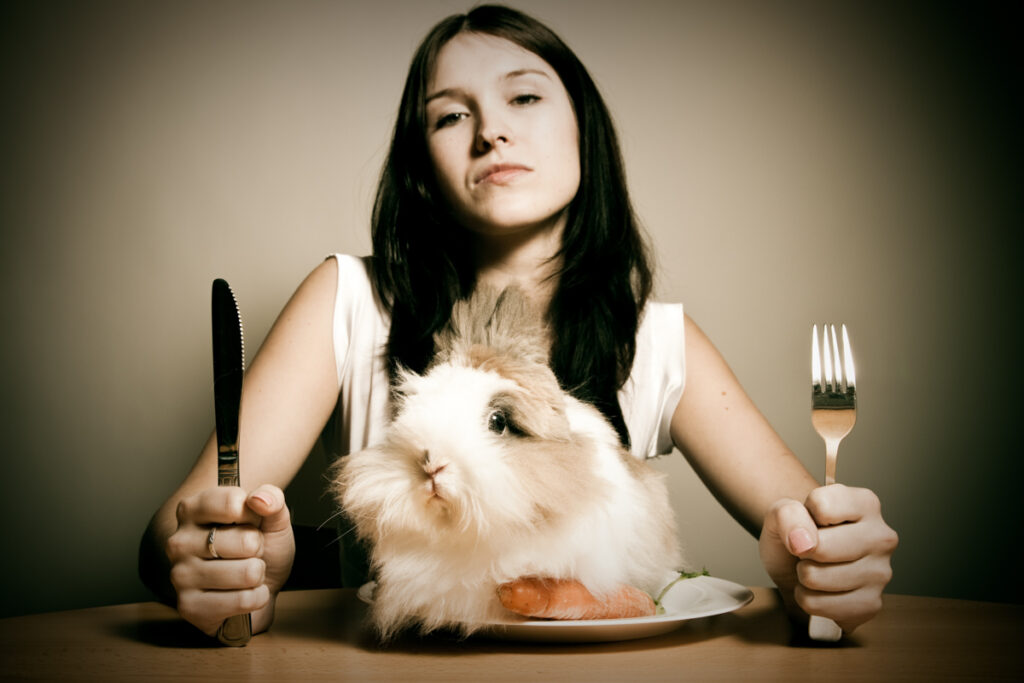The Wall Street Journal created marketing hype for the rabbit-meat industry in the article “Rabbit, Run Or Else…”, which would have us believe that rabbits fit into our economy in one way–as meat. Individuals with vested interests in rabbit meat were used for documentation to convince us that hardworking entrepreneurs are simply satisfying a growing demand for rabbit on the dinner plate.
One source quoted is chef Jacques Pepin, who attributes the growing popularity of rabbit meat to the “increasing sophistication of the American palate.” (We who don’t eat rabbits are unsophisticated?) He does say, however, that if he skinned a rabbit on his PBS cooking show, he would go to jail or “be assassinated by some league or another.”
The next sentence begins with, “In fact, the House Rabbit Society, a national organization devoted to rabbit welfare, occasionally stages a rescue…” The conclusion to be drawn here is that HRS rescuers a) have unsophisticated eating habits and b) are potential assassins.
Implying guilt, the sentence is introduced as a “fact,” when the only factual portion is that [House Rabbit Society is a] national organization devoted to rabbit welfare. [HRS has] never staged a rescue. [HRS rescues], by request, through humane societies, veterinarians, and private parties.
The dual purposes of the American Rabbit Breeders Association–representing breeders who offer recipes for rabbit meatballs as well as representing pet owners–seem to be justification for WSJ to ignore the pet-related industry altogether.
While the increase in rabbit meat sales is proclaimed in self-perpetuating statements by the growers themselves, no mention is made of the 1.44 million households where over 4 million rabbits live as family members, generating a whole industry of pet-rabbit supplies–specialty feeds, indoor cages, dishes, bedding, rugs, litterboxes, toys, playpens–to meet demand for quality care.
We know of our own growth, the products we buy, and the increased number of veterinarians who are treating rabbits. Otherwise it would not be feasible to sponsor our first rabbits-only veterinary conference in the spring of 1997. Where would we be if veterinary students thought they had to enter the meat industry in order to work with rabbits?
To have our numbers count, we must be visible. We need to let veterinary students know they will have abundant clientele with our pets and to let manufacturers know for whom we are purchasing.
We need to mention our companion rabbits at every opportunity. As you buy your veggies, tell the checker they are for your spoiled pet rabbit. When you buy a haytub (utility tub) or cardboard tunnel (concrete form) at the hardware store, say that they are toys for your rabbits. When you buy seagrass mats at the import store, say that you will be back for more, as your pet rabbits will chew them up. And of course, let your pet supply store know that most of the cat litter you are buying is for your rabbits. Let everybody everywhere know that you share your home with rabbit companions and you are buying products for them and they are a substantial part of our economy.
Reward those businesses that are not built around the sale of a rabbit carcass but rather the ongoing products and services that we will need for our rabbit family-members for a long, long time.
©Copyright Marinell Harriman. All Rights Reserved. Republished with the permission of the author.
Rabbit Companions as Dinner: Just Good Business. Right? was originally published in House Rabbit Journal Volume III, Number 9

